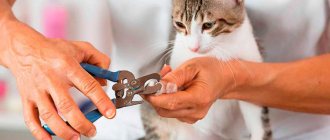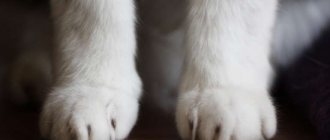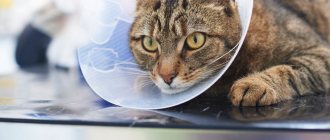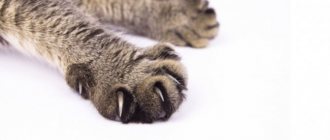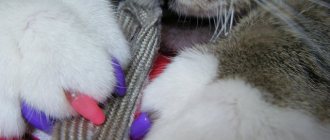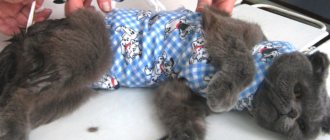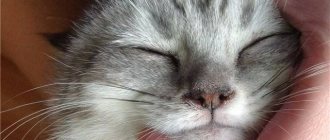- Cats
Some owners of cats and cats, in order to keep the interior of their home safe and sound, to protect family members, especially children, from the threat of being scratched, decide on a rather complex operation - declawing cats, which is called onychectomy.
Features of the operation
During this surgical operation, the claws are removed along with the entire terminal phalanx of the fingers. Veterinarians are mostly opposed to onychectomy. Considering the medical aspect, it should be noted that the removal of the phalanges of the fingers in cats is a very risky procedure: harm from general anesthesia, the risk of infection, and the risk of severe bleeding. If claws are removed incorrectly, the regeneration process may begin over time - the claws grow back, but very often they grow inside the foot, causing pain and suffering in the animal. There is a need for repeated declawing surgery to avoid extensive inflammation of the limbs.
Postoperative care
After surgery, the animal will require special care and attention. To alleviate the animal's suffering, repeated administration of painkillers will be required. To avoid infection of the wound, the sutures must be regularly treated with antiseptic agents. In addition, to prevent the cat from licking its wounds, it should wear a medical collar for two weeks. Three days after the operation, the doctor will examine the patient and give an opinion on the progress of the healing process.
Consequences of the operation
The consequences of the operation may include the following conditions:
- Severe blood loss with serious complications including death
- Loss of coordination due to the need to rely on the pads of the paws rather than on the toes
- Deterioration of gait and subsequent atrophy of the muscles of the limbs and back
- Regeneration of the claw and its ingrowth into the soft tissues of the foot, which leads to repeated surgery
- Long and painful healing process
Given the many risks and unintended consequences, Operation Soft Paws, as onychectomy is commonly called, is drawing protest from animal lovers. The European Convention protecting animal rights has banned onychectomy in many European countries. And even in those countries where this operation is permitted, such as in Russia, veterinarians are opposed to onychectomy.
After declawing, cats may develop arthritis due to the emphasis placed on the pads of their feet when walking. The muscles of the paws and back atrophy, coordination of movements is impaired. A cat that has experienced stress due to this inhumane operation feels completely defenseless, its character deteriorates, and it increasingly uses its last weapon of defense - its teeth.
Mockery of a skeleton
The head of the Moscow City Cat Lovers Club, felinologist Lyudmila Makarova, explained to “360” that for a cat, declawing is the same as getting rid of a nail for a person. Because of this, tactility is also impaired. Moreover, the cat specially sharpens its claws to clear them of husks.
This is a mockery of the skeleton. I would be entirely happy with a law that would prohibit this monstrous act. <…> [Operation] has a negative effect. <…> Of course, the very act of uprooting a claw is a crime against an animal. They'll euthanize him and tear off pieces of his fingers, consider
Lyudmila Makarova.
Photo source: Pixabay
Arguments of supporters of onychectomy
Despite protests from animal rights activists, declawing cats has become fashionable in many countries around the world at some point. Proponents of this operation believe that it is completely safe for the health of the animal. Because declawing occurs under general anesthesia, they say, the cat experiences no pain. Cats begin to walk normally after 5-7 days.
Private veterinary clinics advertise onychectomy, and it becomes one of their areas of activity. Often the operation is performed at home if the cat owner arranges a call to a veterinary surgeon, not wanting to take the animal to the clinic. In this case, the cost of declawing is slightly increased compared to the cost of surgery in a hospital.
Private veterinary services usually warn that declawing can only be performed on cats that are constantly kept at home. If the owners plan to take their pets to the dacha in the summer, where they can come into contact with other animals, then this operation cannot be carried out so that your cat does not remain defenseless against aggression from its own kind. For the same reason, onychectomy is not possible if your cat is outdoors.
Of course, after declawing, the cat will never again sharpen its claws on your furniture, sofas and armchairs will remain intact, and no one will scratch your hands. Therefore, declawing cats is the price for your peace of mind. If you decide to have this operation, then you need to take into account that it is best to carry it out at an early age, then the cat will quickly get used to walking without claws. You can remove claws either on the front paws only, or on all four. After the operation, it is necessary to put a special collar on the cat for two weeks so that it does not remove the bandages from its paws and does not lick the wounds.
And these days, such questions as pros and cons, opinions of specialists and owners and many others related to the onychectomy operation cause fierce debate between its supporters and opponents. Remember, this little creature that you brought into the house is completely in your power, and you simply must create all the conditions for its normal development and good health. After all, you are responsible for him.
Alternative to cat declawing surgery
If onychectomy is not associated with diseases of the claws and phalanges of the fingers, the pet owner should consider all possible alternatives to this operation.
Anti-scratch
Anti-scratch caps are caps for cat claws made of silicone. They are held on the claws using special glue. Despite the presence of anti-scratch pads, the cat leaves the opportunity to release its claws whenever it wants. In addition, pets have a need to sharpen their claws; anti-scratch pads will not interfere with the process, but the furniture will not be damaged, as will the owner’s hands.
Anti-scratch caps are special silicone caps that are placed on a cat’s claws and secured to them with special glue.
The caps cause virtually no discomfort, and the animal can live a full life without limiting its habits. If the cap suddenly falls off and the cat swallows it, it will not cause harm to the pet. Today, anti-scratch products are presented in a wide selection, which makes it possible to choose a suitable option for both a kitten and an adult animal.
Video: how to put on anti-scratch pads for a cat
Trimming
Trimming your pet's nails should normally be done every tenth day. To do this, you need to use a special nail clipper. Each claw is trimmed to just 1 mm. Exceeding this level is prohibited, otherwise bleeding can be provoked. To accustom your pets to nail trimming, the procedure must begin at an early age.
It is necessary to cut off the tip of the claw so as not to damage the blood vessels
Scratching posts
In order to solve the problem of damage to furniture and interior items, it is enough to acquire a special scratching post. It will take some time to get used to it. When your pet starts scratching the furniture, you need to say “No!” in a stern tone. and carry the cat to the scratching post. In this case, you need to take the cat’s paws in your hands and make several characteristic movements. You can also use catnip for training.
It would also be a good idea to play with your pet near the scratching post so that during play he clings his claws to the surface intended for sharpening his claws. Cats quickly understand that this can and should be done here, and they leave the furniture alone.
A scratching post is a necessary attribute of keeping an animal.
Video: how to choose a scratching post and train your pet to use it
Where can they remove claws and how much does it cost?
Not all clinics provide onychectomy, and prices for declawing are quite high. However, everywhere they offer a less radical alternative - nail trimming, which costs from 200 to 500 rubles , depending on the clinic, the cost may vary. In addition, another alternative has recently become widespread - silicone pads. As you can see in the photo, they are put on the claws and last from 3 to 5 weeks.
You need to know that declawing surgery is carried out strictly only for domestic animals, because while walking on the street, the cat will not be able to protect itself in case of danger, or simply climb a tree if attacked by a dog. If you
- The rarest cat breeds
- German Shepherd
- What kind of snakes are kept at home?
- Ancient dog breeds
- Dog's sense of smell
- Maine Coon
After all, we definitely decided that the cost of declawing cats ranges from 1,500 to 4,000 rubles. But currently, many animal protection organizations are fighting to ban declawing in Russia, and many veterinary clinics refuse to do it. In any case, before deciding on such an intervention in the life of an animal, you should think carefully.
Whole milk substitutes
Home \ Advice from veterinarians \ Advice from veterinarians regarding cat nails: cut or remove?
CAT CLAWS
Unfortunately, many veterinary clinics now provide a DECLAW REMOVAL - that is, the area of the toe responsible for the growth of the claw is removed. Many owners of domestic cats easily undergo this operation without knowing or imagining what the risk is for the cat. For veterinarians, this is a business - the operation is quite expensive - so not all of them explain the consequences to animal owners. And driven by good intentions, in ignorance, people make cats disabled! Recently, the practice of trimming cats' claws has become widespread, and in the West even removing them completely. This article from the Auckland Society Against Cruelty to Animals (SPCA) website argues for cat owners to find an alternative to declawing their cats. If you are planning to trim your pet's nails, please take some time to review the information contained in this article. Claws are very important for a cat. The legendary grace and agility of cats, their sense of balance, are largely due to the movable structure of their claws, which assume specific and different positions when walking, running, jumping, climbing a tree, digging, etc. Claws are also the main means of defense. The need for scratching. The outer portion of the claw gradually wears down, so the cat scratches at suitable surfaces to remove the worn portion of the claw, revealing a smooth, sharp new claw tip. Scratching is also a way of demonstrating a very strong instinct - marking one's territory. At the same time, the cat not only leaves visible marks - traces of scratching, but also applies the secretion of special glands to the scratched surface, the smell of which is smelled by all cats. Scratching helps the animal maintain psychological balance, feel comfortable in its territory and train the corresponding muscles. Declawing surgery. The standard procedure is to trim the tip of the claw. In the West, an operation has become widespread in which the area of the toe responsible for the growth of the claw is removed. The operation is usually performed on the front legs. In fact, this is equivalent to amputating the last phalanx of the fingers in humans. The healing and rehabilitation process is very painful for cats. I don’t even want to translate the part of the article describing the medical complications after such a knackering procedure, thank God, our people have not yet reached such barbarity. Please note that even cutting off the very tip of the claw can cause longitudinal cracks and disruption of the correct growth of the claw, which, in turn, can lead to very serious consequences for the animal. Behavior. Although there have been no formal studies of behavioral effects, owners and veterinarians have noted changes in personality in declaw-trimmed cats. Previously active, friendly animals become unsociable and withdrawn. Often, deprived of their usual means of defense, they become nervous, frightened, and/or aggressive, constantly using the last remaining weapon - their teeth. Constant stress caused by a feeling of defenselessness can lead to weakening of the animal's health. Some cats stop using their litter box; it may be associated with the discomfort experienced when trying to “bury” the filler.
Safety: Cats that have been declawed should not leave the premises—their ability to defend themselves or to escape from danger is seriously impaired. Even in an apartment, a cat without claws is at risk. Declawing causes weakening of the muscles in the paws, legs and even the back; the sense of balance also decreases. Combined with the loss of normal dexterity provided by the ability to instantly grip the surface with claws, this leads to the fact that an animal without claws can easily get injured.
An alternative to declawing. Scratching area: Make a post out of scrap material that your cat can sharpen her claws on for fun, and place it in an easily accessible place so that it won't wobble when scratching. The covering should be hard and rough - an old carpet, a tattered felt boot will do, or you can simply wrap it with rope. If you don’t want to do this, such devices are sold at any pet store. If you want to wean your cat from scratching furniture, place the post so that it is in sight of the cat, and gradually move it as you get used to it. Train your cat: while forbidding her to scratch objects not intended for this purpose, be sure to show her what she can scratch. If you notice that the cat is about to scratch the furniture, say “NO” loudly and firmly and move it to the designated area. Place her paws on the post and make a couple of movements with them. If the post is high enough, you can simply sit the cat on it. A water pistol is good for weaning a cat off a bad habit. Every time you show the place, or the cat uses it itself, praise, pet the cat or play with it. You can lightly rub the column with catnip or valerian. At the same time, make your cat's favorite furniture less attractive to her: stick it with adhesive tape or cover it with a soap-scented blanket. Nail care: Regular nail treatment, manicure, so to speak, significantly reduces the consequences of scratching for furniture and the hands of the owners. To do this, it is enough to trim the very tip of the claw, no more than a millimeter, like a person’s nails, and in the same way as a person, with tools specially designed for this. It is better to teach this procedure from kitten age, then, as cats grow up, they even find pleasure in it. When you are first training your cat, start trimming when she is calm or even dozing. Trim only one nail at a time. Talk and praise the cat while you are cutting it and reward it with something afterwards. Be sure to carry out the first haircut in the presence of a knowledgeable person, preferably a veterinarian.
Never use scissors for this, but only special tweezers. Scissors can cause damage to the claw - longitudinal cracks and scuffs.
Hold the pliers perpendicular to the nail being trimmed. Be careful not to touch the sensitive area of the claw; the distance to it should not be less than three millimeters. If you hit this area, your cat will be in pain and may even bleed. If you continually trim the nails too close to the living part, it may shrink.
Alternative
In order for everything in the house to remain in its original form, you should simply wean the cat from sharpening its claws on household objects. To do this, you can purchase a scratching post or make one yourself, building a whole play complex for your beloved pet. The main thing is not to put it off for a long time - it is very difficult to retrain an animal that is already accustomed to sharpening its claws on a soft sofa or a wooden chair leg. In addition, there are special silicone claw covers for animals that refuse to be trained.
The only thing to remember in this situation is that the pads need to be changed monthly.
The best way is to trim the tips of your nails. A more gentle method than surgery is to trim the tips of the claws with special tweezers. Pet owners who are inexperienced in this procedure should be extremely careful. It is preferable to contact a veterinarian so that he can show you how far the claws can be cut. After all, they contain blood vessels, which during the process of circumcision can be damaged and cause in the poor animal not only fear of such a procedure, but bleeding and inflammatory processes.
Should you trim your cat's claws?
Many owners are of the opinion that they should control the growth and sharpness of their cat’s claws on their own. The difficulty is that the animal's claw is riddled with nerve endings that can be easily damaged during trimming. In addition, forced pedicure has other side effects:
- Trimming the nail plate often ends in splitting it. If the crack reaches the blood vessels, the cat can easily get an infection when it tries to sharpen its claws on its own;
- It is difficult to determine “by eye” where the animal’s nerve fibers end in the claw without experience;
- Constant trimming leads to accelerated nail growth, which adds trouble to the owner.
On average, a cat's nails need to be trimmed once a week. It is not always convenient to constantly take the animal to the veterinarian for this, and performing the procedure on your own is risky.
Feedback from pet owners
Vita Trushechkina
But I no longer doubt it. I already decided, today, after the cats went crazy, ran around like crazy and scratched our 9 month old daughter who was sitting playing on the floor. I'm not even talking about how scared she was. And yesterday I saw how one of the cats wanted to hit my daughter, but saw me and ran away. So I won't wait for them to claw her eyes out. I love our cats, but the child and his safety are more important.
Svetlana Skibenko
I'm sorry, but why are we talking only about sofas? Let's talk about the hostess's health! My cat is very affectionate and peaceful, he has been in our family since two months and has seen only tenderness - he is our favorite. But sometimes he has attacks of aggression or fear (for example, he was afraid of a working food processor) - he attacks me, his mistress. He has already repeatedly torn my legs to pieces, a couple of times even the ambulance took me away. The doctors advised me to get rid of the cat, but, again, I love him very much and don’t want to part with him. But I am still constantly afraid of his attacks. My legs are covered in terrible scars and in the summer I can’t even go to the beach! Moreover, this threatens blood poisoning. So what should I do - sacrifice the cat or is it better to use his claws?!
Jennifer
We declawed our cat. And it was a damn good decision. While all the wallpaper in our house was torn, shreds of carpets flew in all directions, etc. I endured it, trimmed the cat’s claws, ran after him with a scratching post, and so on. He sneezed on me and all my efforts. But when he with his claws jumped onto the hanger where my expensive leather jacket from Italy and my husband’s equally expensive sheepskin coat were hanging…. and, clinging to the jacket with one paw and the sheepskin coat with the other, he slid down, tearing shreds out of our clothes - this was the last straw. He was given general anesthesia and only the claws on his front paws were carefully removed. A week later he was jumping around like a saiga.
